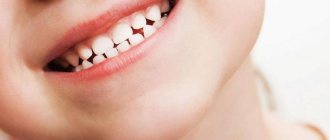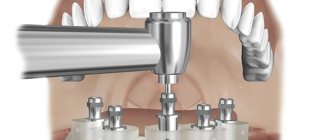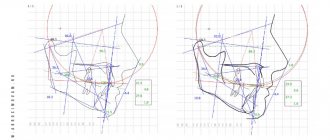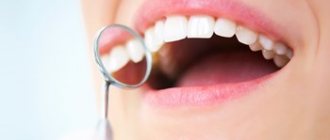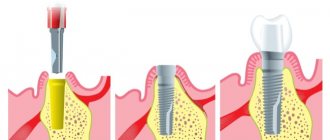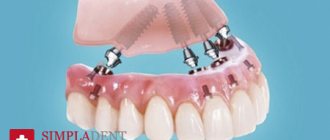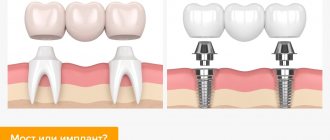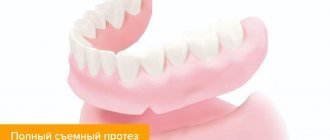Modern methods in dentistry, including the latest technologies in implantation, can solve almost any problem, including complete absence of teeth. However, installing a large number of implants entails large financial and time costs. It is not surprising that a system that requires only four implants and reduces surgical time can be considered the most optimal option for most patients. Dmitry Valerievich Levin, candidate of medical sciences, chief physician and implant surgeon of the Doctor Levin Center for Private Dentistry in Moscow, talks about the features of all-on-4 or “all on four” implantation.
What is All-on-4 implantation?
“All on four” implantation is the fixation of fixed dentures on four implants installed in the upper or lower jaw. The prosthesis is fixed on implants using special screws, which ensures good stabilization. Only a doctor can remove such a prosthesis; this usually happens twice a year - for inspection and necessary preventive measures. The patient’s attendance at such preventive examinations is strictly mandatory, as this prevents the development of possible complications.
Prosthetics with permanent dentures
Prosthetics is the protection of teeth and restoration of lost elements based on removable and fixed dentures.
Prosthetics after All-on-4 with permanent dentures
Permanent dentures on implants are conditionally removable artificial teeth made of acrylic (plastic), nylon or metal-ceramics or fixed dental bridges. They fit tightly to the gums, replacing missing ones. Permanent dentures are attached to implants (4 or 6 pieces).
What types of dentures are there on implants?
- complete dentures (full set) - which replace all of your upper or lower teeth;
- partial dentures - replacing just 1 tooth or several missing teeth.
Advantages of prosthetics on four implants
The method has been used for a relatively short time, but the technology has a number of undeniable advantages: 1. Prices for dental prosthetics on four implants are much lower.
2. The patient can save a lot.
3. No sinus lift required
4. It is possible to carry out implantation with immediate loading and immediately secure the dentures in the oral cavity.
5. There is no fear that dentures will fall out;
6. When using implants, the service life of the dental prosthesis itself increases by approximately 2-3 times.
Adaptive and permanent type of dentures with complete edentia - what is the difference
An adaptive prosthesis is considered temporary, but it can be worn even for more than 3 years.
The adaptive structure is placed in order to form a correct bite and correct the functioning of the jaw joints.
Good orthopedist for All-on-4 prosthetics
Orthopedist Ostapenko Yu.V.,
Orthopedist - Ostapenko Yuri Vladimirovich - highly qualified.
Orthopedist specialization
Prosthetics on implants, All-on-4, crowns, veneers, bridges, clasp dentures, etc.
Education
In 1985 he graduated from SSMU (Arkhangelsk) with a degree in Dentistry. D
iplom - internal combustion engine 0589821.
In 1986, he completed an internship at the Velsk Central Regional Hospital, specializing in therapeutic dentistry.
Types of dental prosthetics on implants
Prosthetics on implants
Clasp prosthetics on 2 implants
Types of fastenings:
- Clasps - using special hooks.
- Attachment - the structure resembles a snap button, which reliably fixes the entire structure.
- Telescopic dentures look the most natural of all clasp dentures.
Partial dentures are made on 2 implants
A partial denture is designed to fill the gaps left by one or more missing teeth. It is usually attached to some of your natural teeth using metal clips that hold it securely in your mouth. If necessary, 2 implants are placed and prostheses are attached to them.
A partial denture includes crowns that are placed on implants on either side of the gap and connected by false teeth that are inserted into the gap. This design is called a dental bridge or dental bridge on implants. In this case, there should always be an even number of implants, 2 or more. A removable prosthesis on 2 implants with attachments is used in cases where there is not enough bone tissue to install 4.
Prices for clasp dentures in Kaliningrad
- Clasp clasp prosthesis from RUB 28,500.
- Clasp combined prosthesis (metal + monomer-free plastic) from RUB 42,800.
- Clasp prosthesis with locking fastening on two supporting elements from RUB 43,900.
Dental implantation in Kaliningrad reviews
Complete dentures on 4 or 6 implants
A complete denture will be fitted if all of your upper or lower teeth need to be removed (edentulous) or if you need to replace an old full denture.
Before installing a permanent prosthesis, the stability of the implant is tested to avoid unnecessary complications.
Removable overdentures
In removable prosthetics on implants, a cover-type prosthesis with spherical attachments that will completely cover the palate is usually fixed on four titanium implants.
Dentures without a palate for removable prosthetics on implants in the complete absence of teeth can be fixed using micro-locks, locators, or a beam.
The maximum strength of fastening is provided by a beam in a removable prosthesis, but the price of the prosthesis is equal to the cost of a fixed bridge (for example, made of metal ceramics).
Fixed dentures for the upper jaw
Fixed prosthetics on implants in the upper jaw require the installation of six to eight implants. The exact number of implants for prosthetics is selected based on the condition of the bone tissue and jaw.
While the implants are healing, the patient is given a temporary prosthesis made of polymer material. Prosthetics on implants (all on four) can also be conditionally removable. In this case, implants with screw fixation (abutment) are used.
Fixed prosthetics completely imitate their own teeth and are liked by Patients psychologically.
The bone tissue of the upper jaw is less dense, therefore, for complete prosthetics, more implants are often placed on implants - from 4 to 8, and the production time for a permanent prosthesis is extended to 6 months.
Fixed prosthetics of the lower jaw
Fixed prosthetics of the lower jaw is carried out on 6 implants or using the all-on-4 method, but in this case 2 of the 4 implants are placed at an angle of up to 45 degrees.
The service life of a temporary plastic prosthesis is 1 year. Then it is replaced with a permanent non-removable metal-ceramic or zirconium implant after complete healing of the implants. The implants themselves are not affected.
Fixed dentures are popular because of the feeling of having your own teeth that stand firmly in your mouth (psychological effect).
How much do individual implant dentures cost in the region?
- The cost of an acrylic denture in Kaliningrad starts from 11,000 rubles for a partial denture, and from 12,000 rubles for a full jaw denture.
- The cost of a nylon prosthesis is from 25,000 rubles.
- The cost of clasp prosthetics starts from 43,000 rubles: the cost depends on the type of fixation - clasps (hooks) or locks.
- Metal-ceramic crowns without a promotion start in Kaliningrad from - 8,300 rubles.
Prosthetics on implants cost per 1 tooth?
The cost of 1 unit with a metal-ceramic crown on an implant is from 18,900 thousand rubles to 26,600 rubles.
Clasp denture price
Caring for dentures on implants
Dentures may seem a little strange at first, but you will soon get used to them.
When wearing dentures, it is equally important to keep your mouth clean.
It is important to regularly remove plaque and food debris from your dentures.
ADVANTAGES OF BAR CONSTRUCTION OF IMPLANT-BASED DENTURES
1. When installing a beam inside a removable denture, the chewing load is evenly distributed between all implants and the bone
2. The beam is fixed on the implants in the spaces between the metal roots and reliably fixes not only the removable denture, but also the implants (not allowing them to become loose. 3. The beam prosthesis is easy to maintain and allows you to remove the beam and change the design to any other. For example, when moving from temporary to permanent dentures. 4. A fixed and installed denture does not move during meals (when chewing food), therefore it does not cause discomfort to the person and inconvenience when handling the denture. But if necessary, the dentist will always be able to remove the denture from the implants without damage.
Features of complete removable dentures (traditional)
Removable dentures are considered the most economical option.
But the presence of a voluminous artificial palate on the upper jaw and massive gums on the lower jaw causes a feeling of discomfort, nausea and changes in sounds when speaking.
- All chewing pressure spreads to the gums and pain appears when chewing,
- Over time, the gums inevitably develop redness, ulcers, bleeding,
- The prosthesis is poorly fixed on the gums, unlike implants.
What are the indications for All on Four dental implants?
One of the indicators can be the small volume of bone tissue in both the upper and lower jaws. It is especially problematic with the required volume of bone tissue for implantation in the chewing sections, since in the absence of teeth for quite a long time, the volume of bone tissue in these sections decreases, and this happens even when using removable dentures. In order to install the number of implants required for fixing fixed prostheses (from 6 to 10), a preliminary operation is required to restore the required bone volume. Only after this are implants installed, and after some time (from three to eight months) prosthetics are performed on them.
Myth 3. The prosthesis is not fixed securely and cannot withstand heavy loads.
As a rule, prosthetics using the All-on-4 system involves screw fixation of the orthopedic structure. The use of this method makes it possible to securely fasten the prosthesis to the supporting elements, ensuring its stability. The screws are wear-resistant, do not wear out or break when using the prosthesis. However, they have an expiration date, after which the retainers must be replaced. As a rule, this is 10 years, but if the rules of use and care are followed, screw fastenings can last longer.
What are the advantages of dental prosthetics with 4 implants?
If we compare the “All on Four” technique with the use of removable dentures, the difference will be that in the first case the risks of mucosal injury, bone loss, as well as difficulties with fixation and correction are reduced to zero.
A patient with a removable denture experiences discomfort both functionally and socially. Most people who use removable dentures experience some self-doubt, and sometimes even inferiority in their social status. Also, when installing “all on four” implants, as already mentioned, there is no need for a large number of implants. Due to the fact that these four implants are installed in certain positions in relation to each other: when implanting the front teeth - straight, and in the lateral teeth - at an angle of 35º to 45º, and also by creating a large distance between them, the chewing load is adequately distributed and is redistributed during operation. A small number of implants simplifies the operation, making it faster and more predictable, while ensuring excellent results.
Myth 5. Four implants quickly become loose due to bone atrophy.
The reliability of the All-on-4 method is high if the following conditions are met:
- The patient has no contraindications, to identify which a complete examination of the jaw bone was used.
- The operation is carefully planned and performed by an experienced specialist, using high-quality materials.
- The patient complies with all recommendations for care, use and prevention.
As for atrophic changes in bone, after applying the “All on 4” method, the loss of hard tissue slows down significantly and its rate is 0.03–0.05 mm per year. When wearing removable dentures, bone resorption reaches 1 mm annually.
What types of prostheses are used when implanting All-on-4?
For “All on Four” implantation, fixed prostheses are always used, which, however, can be called conditionally removable, because they are fixed with special screws, but at the same time they are fixed rigidly. The patient is not able to remove them while wearing them; I repeat, this can only be done by a doctor for regular checks.
Designs of this type have stood the test of time, showing excellent clinical results. The reliability of work done using this technology is beyond doubt. A large number of patients choose this technology and are very satisfied.
Treatment specialists
Beldy Nikolay Olegovich
Chief physician, orthopedic dentist
Work experience: more than 19 years
Harutyunyan Arthur Aikovich
Orthopedic dentist, implantologist
Work experience: more than 7 years
Doctors completed a special course on the concept of All-on-4 and Trefoil implantation
Sign up for a consultation
Do you dream of getting all your teeth back in 1 day?
Sign up for a consultation!
Preparation for implantation using All-on-4 technology
No special preparation is required, but if there are foci of infection in the planned location of the implants that can affect the quality of the intervention, they require preliminary relief. If there are roots of decayed teeth or loose teeth in the oral cavity, they are removed during surgery.
Before the operation, the patient must undergo examination: blood tests, X-ray diagnostics. If everything is in order and the patient does not suffer from systemic diseases, including diseases of the blood and immune system, he can safely count on this operation. We usually offer different types of implantation, but with such a defect as the complete absence of teeth in the upper or lower jaw, “all-on-four” implantation always wins: both in terms of treatment cost and time savings.
Make an appointment
right now!
Levin Dmitry Valerievich
Surgeon, Implantologist, Maxillofacial surgeon
Features of the All-on-4 implantation procedure
The traditional All-on-4 procedure boils down to the following:
- After studying the OPTG and CBCT data, the dentist determines the best places to install the DI;
- The operation begins with anesthesia and the formation of a folding mucoperiosteal flap;
- A standard template is applied to the jaw, according to which the doctor determines the places for screwing in titanium supports;
- Two implants are installed in the frontal area strictly vertically in relation to the jaw;
- The remaining two implants with multi-units are installed obliquely at an angle of 35-45 degrees in the lateral areas - one on each side of the jaw;
- The flaps are returned to their places, the wounds are sutured;
- The operation is completed by screw fixation of a temporary acrylic prosthesis to the established DI for up to 6 months;
- After 10-12 days, the sutures are removed and the temporary prosthesis is returned to its place;
- After the period of complete osseointegration of the implants, a complete removable denture (no more than 12 units) is made from acrylic or with a titanium or zirconium bar lined with ceramics. In addition, there are possible options for prosthetics with fixed bridge structures or conditionally removable products with locking fasteners.
The inclination of the DI provides a larger area of contact of the titanium root with the bone, especially with its cortical layer, due to which the future fixed prosthesis will be more stable in the oral cavity, and important maxillofacial structures (maxillary sinus or mandibular nerve) are not affected.
A permanent prosthesis has a base that completely covers gum defects formed due to a long absence of teeth. It is for this reason that there is no need for bone grafting and gingivoplasty (surgery to increase the height of the gums).
More advanced, but also technically complex, is the implantation procedure using an individually modeled 3D surgical template, which is printed and applied to the jaw before the operation. This ensures maximum accuracy of DI placement. The protocol can be performed either with a flap detachment or using a flapless technique, i.e. through gum punctures.
Work examples
How often do you visit the dentist?
All-on-4 implantation technologies
This operation, in its essence, differs little from a number of similar implantation operations. Its only difference is that after installing the implants, provided they have good primary fixation, they immediately begin to “work.” This means that they can either be immediately fitted with a new fixed prosthesis, or the patient’s old (removable) prosthesis can be fixed, making it permanent. This manipulation usually takes about 3 - 4 hours. The mucous membrane, injured during surgery, does not suffer at all, since the load is not distributed on it, but directly on the installed implants. In fairly complex cases, when the volume of bone tissue is minimal, the patient will be advised to make an individual template made in 3D format based on a tomogram image. At the preparatory stage, the doctor plans the route of insertion of the implants into the jawbone, and only then during the operation they are installed using a manufactured template. After 4-6 months, during which a temporary fixed prosthesis is used, a permanent fixed prosthesis is made that will last for many years.
Photos before and after All on Four implantation
Features of the classic protocol
Classical implantation is a two-stage process: in the first stage, implants are implanted, in the second, a prosthesis is installed. Between stages, a certain amount of time passes, necessary for the fusion of titanium roots with the jawbone. Implantation of titanium roots occurs using the patchwork method - the doctor cuts the gum, folds back the mucous flap, forms a hole in the bone into which the root-like implant is screwed and sutured the wound.
After complete osseointegration (after 3-6 months), the gum is cut again, and a gum former is fixed to the implant to achieve the desired aesthetics of the gingival margin. After 10-14 days, the former is replaced with an abutment, onto which a permanent prosthetic structure is attached. In case of bone atrophy, before installing a titanium root, it is necessary to do directed osteoplasty (on the lower jaw) or sinus lift (on the upper jaw).
Are there any complications after the procedure?
Complications, of course, occur, for example, such as a fracture of the base of the prosthesis, but this can only happen with a temporary structure. With permanent restoration this is unlikely to happen. Also, at the early postoperative stage, inflammation of the mucous membrane may occur, but in the future, the formed mucous membrane remains healthy with proper care. The worst thing that can happen is perimlantitis - inflammation of the tissue near the implant caused by the appearance of pathogenic microbes between the implant and the bone tissue that holds it. That is, in essence, this is the destruction of the bone fragment that holds the implant. However, with careful care and good oral hygiene, in particular denture hygiene, this will not happen.
How many implants should I choose?
In addition to All-on-4, there are modifications of this technique. for example, All-on-6 implantation. If there is a sufficient amount of bone tissue, install an additional 1-2 titanium pins, which will significantly reduce the risk of loosening the structure. Don't forget, everything on four can turn into nothing on three. Despite the high percentage of their survival rate (98-99%), one or two percent still sometimes happen. The more implants, the less risks.
The classic All-on-4 technique requires the installation of relatively long implants. Not all patients have enough bone tissue to have them installed without augmentation. In this case, installing shorter models, but in larger quantities, compensates for the insufficient length of the implants.
Do not forget that implantation using the All-on-4 method implies that the load of the teeth of the entire jaw will be carried by only 4 implants. An important factor is the condition of the patients’ masticatory muscles. Four artificial roots are enough for women and older people. Adult men with developed chewing muscles will develop a greater chewing load. In this case, the manufacture of a fixed prosthesis for 4 implants will carry additional risks. Fortunately, with well-developed muscles, the bone tissue of the jaws is also well preserved. This allows you to install an additional 1-2 implants to evenly distribute the chewing load.
Different options for the number of implants in the absence of teeth (from left to right):
- Six implants on each jaw, two on the upper jaw are installed at an angle, bypassing the maxillary sinuses, on the lower jaw there is a classic installation.
- Six implants in the upper jaw and four in the lower jaw, some of them are installed at an angle.
- Four implants in the upper jaw, two are installed at an angle, bypassing the maxillary sinuses.
Primary adaptive prosthesis
The use of an adaptive prosthesis, which is initially placed on the patient, is a necessary step on the path to a permanent one. It can be quickly adjusted to the changing relief of the gums, adjusted to antagonist teeth, and can also be easily repaired.
Functions of an adaptive prosthesis
- Chewing load. The sooner you start chewing with your new teeth, the faster the osseointegration (engraftment) of the implants into the bones will occur.
- Aesthetics. You will be able to smile openly again without embarrassment, since artificial teeth are indistinguishable from real ones.
- Easy to maintain. An adaptive fixed denture will go through a number of modifications in order to exactly follow the topography of your jaw over time. This means that food will not get stuck between the artificial and real gums.
But using an adaptive prosthesis for more than the period recommended by the dentist can lead to negative consequences.
With very long-term use of an acrylic adaptation prosthesis, the following is possible:
- The appearance of an allergic reaction. Not every organism is able to withstand prolonged contact with plastic (acrylic); it is necessary that the prosthesis does not touch the gums;
- Breakage (plastic is a fragile material and is susceptible to aging). A hidden crack can change the distribution of load on the implants and cause overload of one of them;
- Incomplete loading of the implants (on an adaptive prosthesis it is impossible to make releases beyond the distant implant without fear of breakages in these areas, because the strongest chewing load occurs there).
Although we recommend changing the primary adaptive prosthesis to a permanent one six months after installation, we are well aware that not all patients have this opportunity. Therefore, we have found a way out of this situation and propose using a reinforced adaptive prosthesis to extend the service life. The reinforcement is a titanium beam with holes through which the adaptive prosthesis is attached to the implants, and onto which acrylic gums and teeth are “fused.” This design can last up to 3 years, and during this time you can already save up for a permanent prosthesis.


